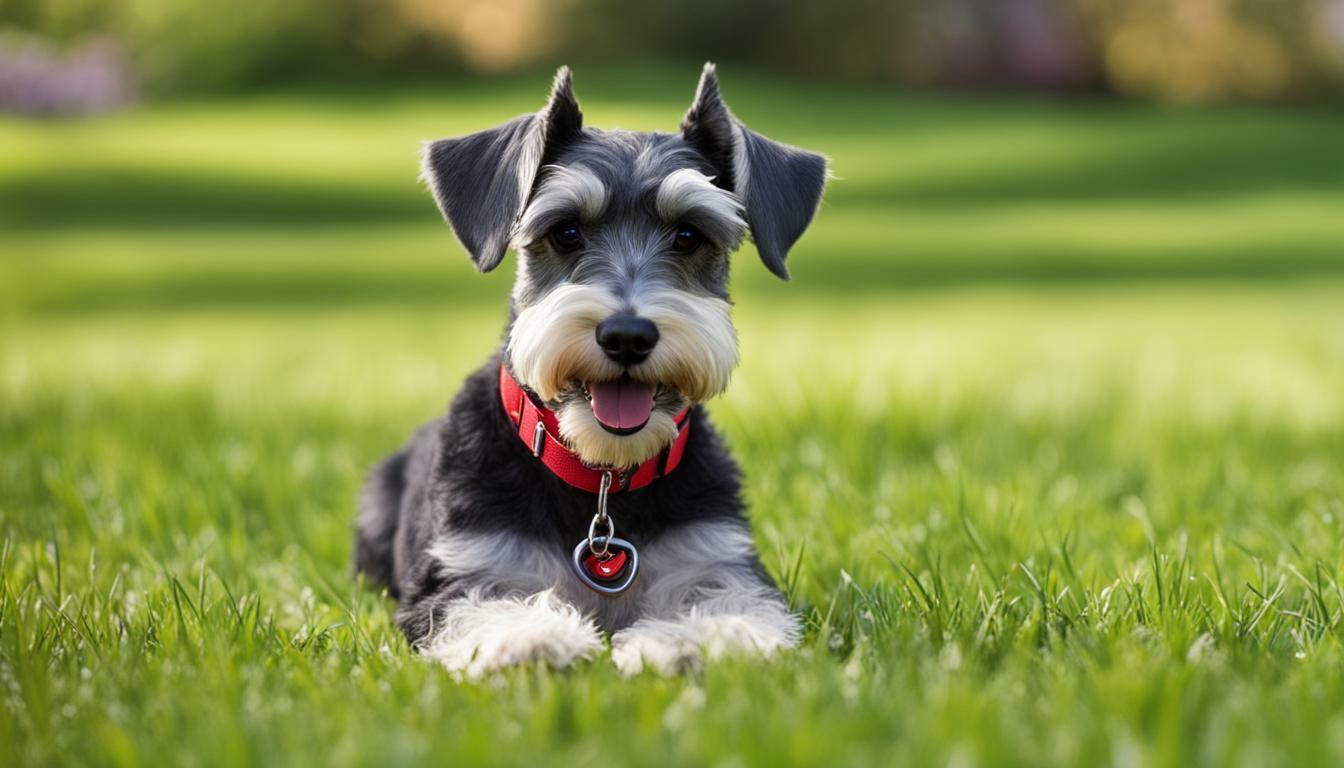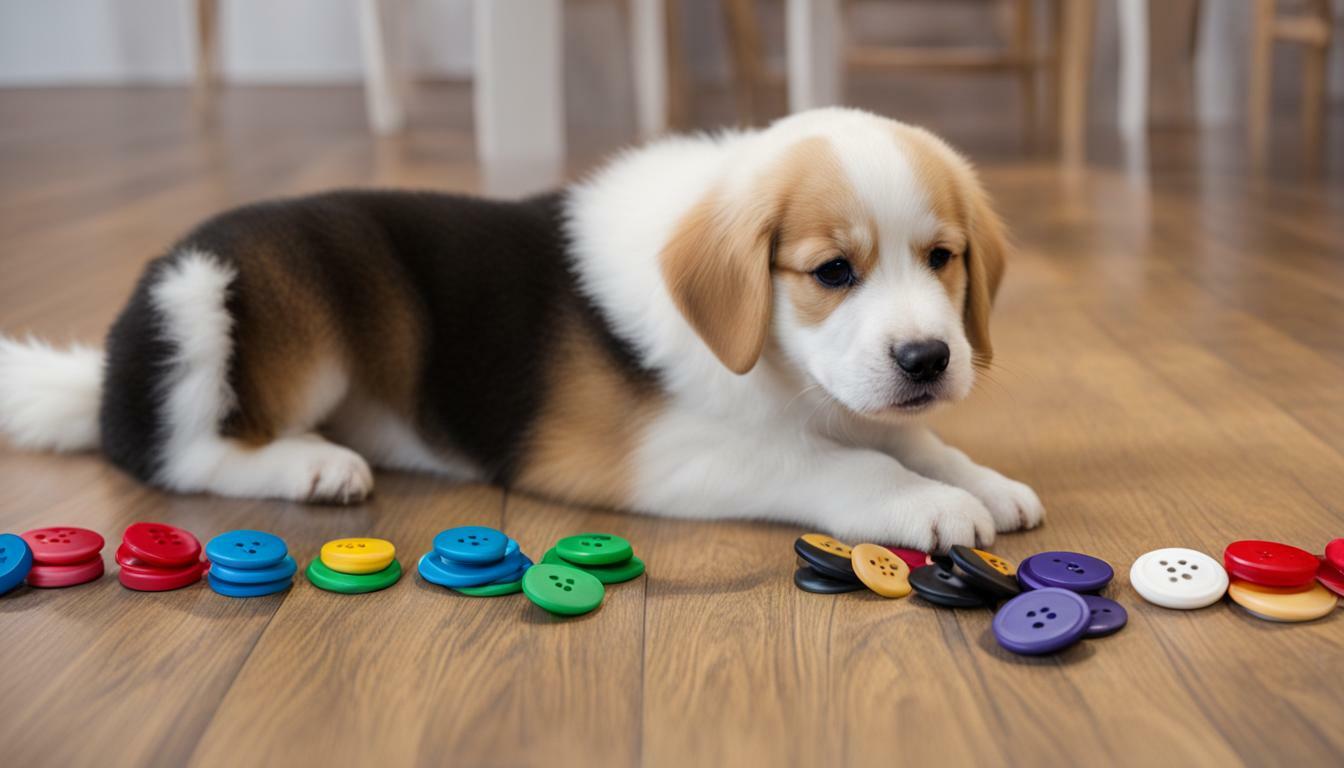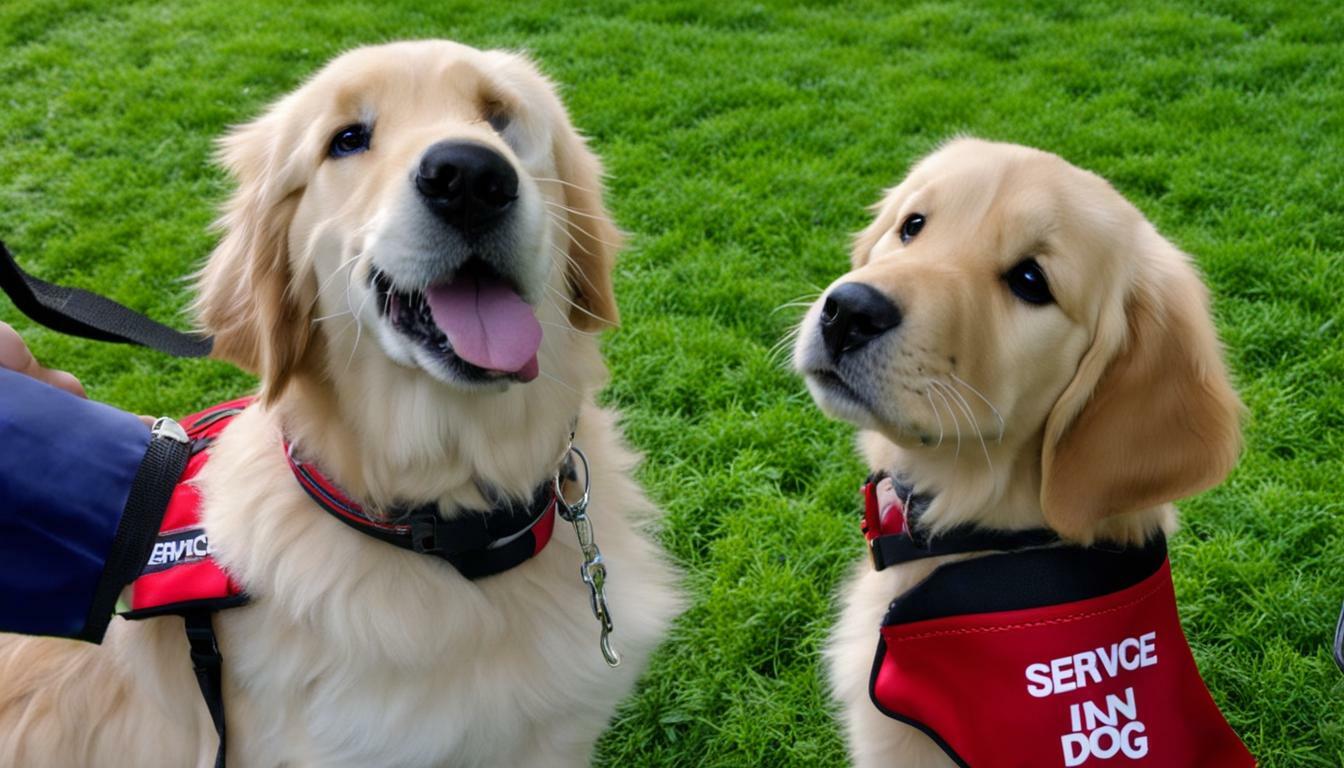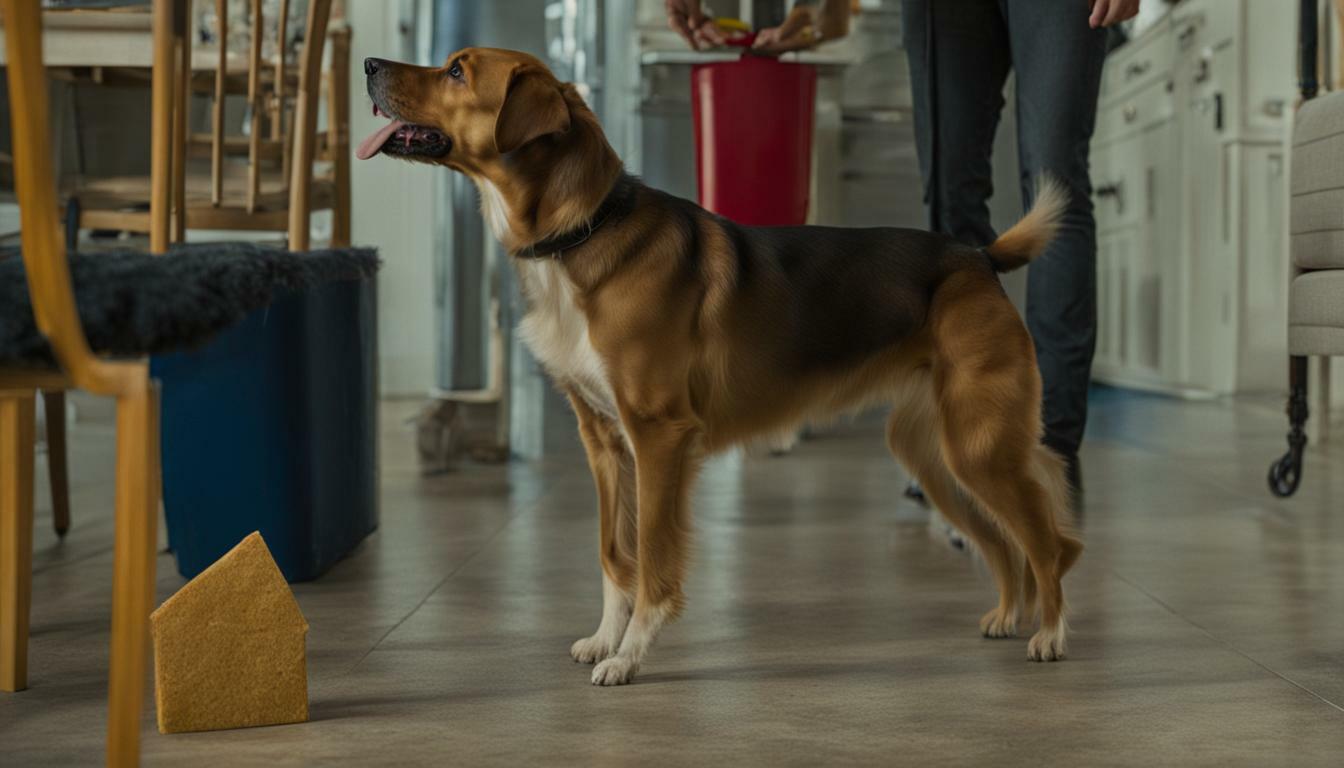Are you ready to unlock the secrets of Miniature Schnauzer training and create a well-behaved and obedient pup? Training a Miniature Schnauzer requires specific techniques and knowledge, and this comprehensive guide is here to help you every step of the way. With the right training, you can ensure that your Miniature Schnauzer grows up to be a happy and well-adjusted companion.
- Miniature Schnauzer training requires patience, consistency, and positive reinforcement.
- Understanding the specific needs of Miniature Schnauzers is crucial for successful training.
- Proper socialization and obedience training are essential for a well-behaved Miniature Schnauzer.
- Crate training can be highly beneficial for housebreaking and providing a safe space for your Miniature Schnauzer.
- Seeking additional resources, such as books or professional trainers, can enhance your training journey.
By following this comprehensive Miniature Schnauzer training guide, you’ll be equipped with the knowledge and techniques necessary to raise a happy and well-behaved four-legged friend. So let’s get started on this exciting training journey together!
Miniature Schnauzer Training Tips
Training a Miniature Schnauzer can be a rewarding experience, and these tips will help you set off on the right foot. The key to successful training is consistency and positive reinforcement. Here are some important tips to keep in mind:
- Start early: Begin training your Miniature Schnauzer as soon as you bring them home. Early socialization and obedience training are essential for a well-behaved adult dog.
- Use positive reinforcement: Reward your Miniature Schnauzer with treats, praise, and affection when they exhibit desired behaviors. This positive reinforcement will motivate them to repeat those behaviors.
- Be patient and consistent: Training takes time and repetition. Set aside regular training sessions and be consistent with your commands and expectations. Patience and consistency will yield the best results.
- Focus on basic commands: Start with teaching your Miniature Schnauzer basic commands like sit, stay, come, and heel. These commands form the foundation of their training and will make everyday life easier for both you and your dog.
- Use a variety of training techniques: Different dogs respond to different training methods. Experiment with positive reinforcement, clicker training, and leash training to see what works best for your Miniature Schnauzer.
Remember, every dog is unique, and training methods may need to be tailored to suit your Miniature Schnauzer’s individual needs. Stay patient, consistent, and always prioritize your dog’s well-being throughout the training process.
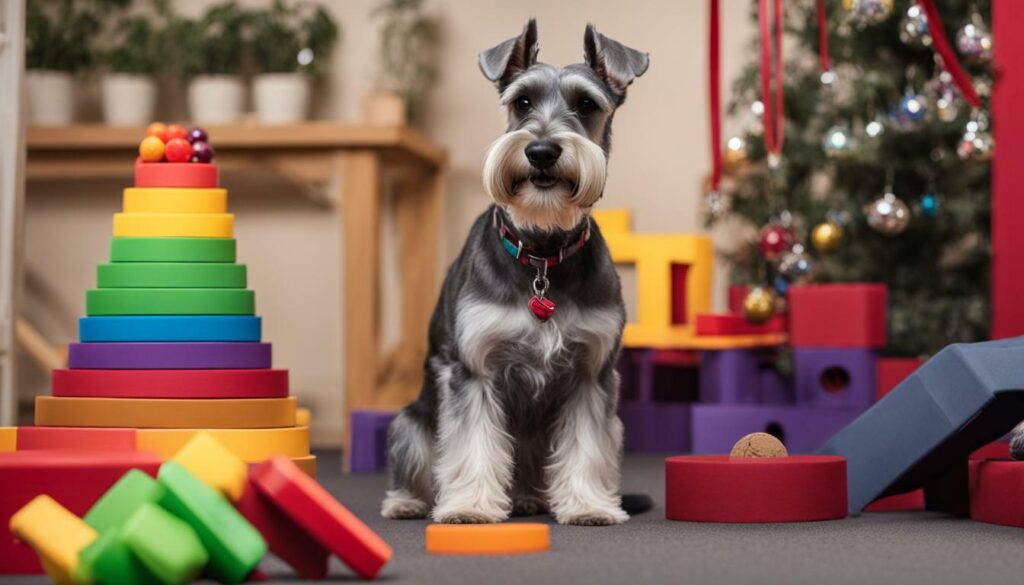
For more in-depth training guidance, continue reading our complete Miniature Schnauzer training guide.
Miniature Schnauzer Obedience Training
Obedience training is a crucial aspect of Miniature Schnauzer training, and in this section, we will delve into the fundamental commands and techniques. By establishing clear boundaries and teaching your Miniature Schnauzer basic obedience commands, you can ensure a well-behaved and happy companion.
One of the first commands to teach your Miniature Schnauzer is “sit.” This command is not only useful in controlling your dog’s behavior but also acts as a foundation for other commands. To train your dog to sit, hold a treat close to their nose, then slowly move it upward. As their head follows the treat, naturally, their bottom will lower into a sitting position. Once they are in a sitting position, say the word “sit” and reward them with the treat. Repeat this process several times a day until your dog can sit on command.
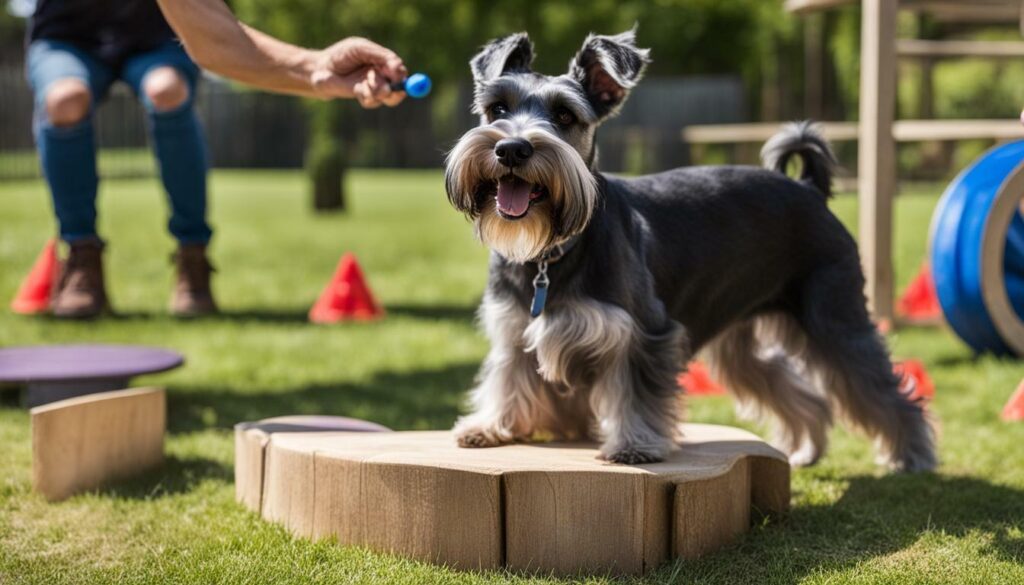
| Command | Description |
|---|---|
| Stay | This command teaches your Miniature Schnauzer to stay in one place until given a release command. Start by commanding your dog to sit, then hold your hand up with the palm facing towards them, and say “stay.” Take a step back and if they remain in place, praise and reward them. Gradually increase the distance and duration of the “stay” command. |
| Come | Teaching your Miniature Schnauzer to come when called is essential for their safety. Begin by putting a leash on your dog and gently pulling them towards you as you say their name followed by “come.” Reward them with praise and treats when they successfully reach you. Practice this command in a controlled environment before using it in distracting situations. |
| Leave it | This command helps prevent your Miniature Schnauzer from picking up or chewing on potentially harmful objects. Hold a treat in your closed hand and say “leave it.” When they stop sniffing or pawing at your hand, reward them with a different treat. As they begin to understand the command, you can introduce the cue without a treat in your hand. |
Consistency, patience, and positive reinforcement are key when training your Miniature Schnauzer. Remember to keep training sessions short and enjoyable for both you and your dog. With these obedience training techniques, you can establish a strong bond with your Miniature Schnauzer while ensuring their safety and well-being.
Miniature Schnauzer Puppy Training
Training a Miniature Schnauzer puppy requires a different approach, and in this section, we will explore the essential aspects of puppy training. Puppies are at a crucial stage of development, and proper training during this period can set the foundation for a well-behaved and obedient adult dog.
One of the first steps in training your Miniature Schnauzer puppy is establishing a consistent routine. This includes feeding, potty breaks, playtime, and training sessions. Dogs thrive on routine and structure, so it’s important to establish a predictable schedule to help them understand what is expected of them.
Socialization is another vital aspect of puppy training. Introduce your Miniature Schnauzer to various people, animals, and environments to ensure they grow up to be confident and well-adjusted. Enroll in puppy socialization classes or organize playdates with other friendly dogs to provide positive experiences and opportunities for social interactions.
| Training Tip: | Use positive reinforcement techniques, such as treats, praise, and rewards, to motivate and encourage your Miniature Schnauzer puppy. This will help them associate good behavior with positive outcomes and make training sessions enjoyable for both of you. |
|---|
Potty Training a Miniature Schnauzer Puppy
Potty training is an essential aspect of training your Miniature Schnauzer puppy. Start by establishing a designated potty area outside and consistently take your puppy to this spot after meals, playtime, and naps. Use verbal cues, such as “go potty” or “do your business,” to help them understand what is expected. When your puppy eliminates in the correct spot, reward them with praise and treats. Accidents are bound to happen, so be patient and avoid punishment, as it can create fear or anxiety.
Remember to keep training sessions short and frequent, as puppies have shorter attention spans. Focus on teaching basic commands, such as sit, stay, and come, using positive reinforcement. Be consistent with your commands and expectations, and gradually increase the difficulty of the exercises as your puppy progresses.
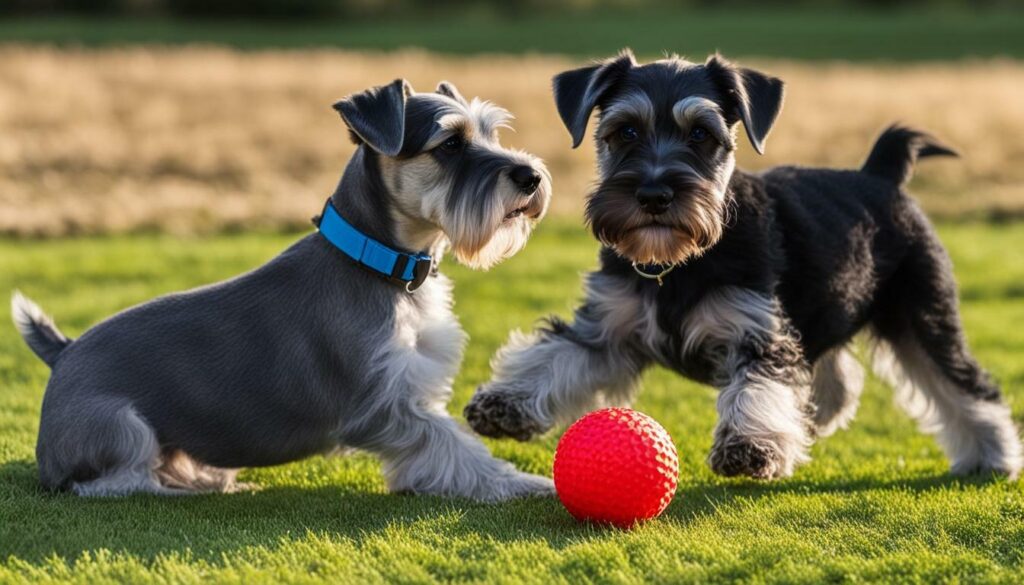
By following these training tips and techniques, you can lay a solid foundation for your Miniature Schnauzer puppy’s future behavior and obedience. Remember, patience, consistency, and positive reinforcement are key to successful puppy training.
Miniature Schnauzer Behavior Training
Is your Miniature Schnauzer exhibiting unwanted behaviors? This section will provide effective strategies for behavior training. It is essential to address these behaviors early on to ensure a well-behaved and happy dog. Whether your Miniature Schnauzer is displaying excessive barking, jumping on guests, or struggling with separation anxiety, proper behavior training can make a significant difference.
One effective technique for behavior training is positive reinforcement. This involves rewarding and praising your Miniature Schnauzer for desired behaviors, such as sitting calmly or avoiding jumping. By using treats, toys, or verbal praise, you can reinforce positive behaviors and discourage unwanted actions. Consistency is key in this training method, as your dog will learn to associate good behavior with a reward.
Another important aspect of behavior training is socialization. Exposing your Miniature Schnauzer to different people, animals, and environments can help them become more comfortable and confident in various situations. Gradually introduce your dog to new experiences, ensuring they remain calm and positive throughout the process. Socialization can minimize fear-based behaviors and promote a well-rounded and adaptable canine companion.
| Behavior Issue | Training Technique |
|---|---|
| Barking | Teach the “quiet” command, redirect attention, and provide mental stimulation. |
| Jumping | Ignore the behavior, reward calm greetings, and teach an alternate behavior like sitting. |
| Separation Anxiety | Gradually desensitize your dog to your absence, establish a consistent routine, and provide comforting toys or clothing with your scent. |
Remember, behavior training takes time and patience. It is important to remain calm and consistent throughout the process. Seek guidance from a professional trainer if needed, as they can provide personalized strategies and support for your Miniature Schnauzer’s specific behavior issues. With dedication and the right training techniques, you can shape your Miniature Schnauzer into a well-behaved and happy family pet.

Discover a range of effective training techniques tailored to the unique needs of Miniature Schnauzers in this section. Training your Miniature Schnauzer requires patience, consistency, and positive reinforcement. By implementing these techniques, you can ensure a well-behaved and happy companion.
Positive Reinforcement
One of the most effective training techniques for Miniature Schnauzers is positive reinforcement. This method involves rewarding your dog with treats, praise, or play when they exhibit desired behavior. For example, when teaching your Miniature Schnauzer to sit, reward them with a treat and praise every time they successfully sit on command. This positive reinforcement will encourage them to repeat the behavior and reinforce their understanding of the command.
Clicker Training
Clicker training is another valuable technique that can be used specifically for Miniature Schnauzers. This method involves using a clicker, a small device that makes a clicking sound, to mark desired behavior. By pairing the clicker with treats or rewards, you can effectively communicate and reinforce desired actions. For instance, when training your Miniature Schnauzer to stay, use the clicker to mark the moment they remain in position, and then reward them with a treat. Over time, your dog will associate the clicker sound with positive reinforcement and be more responsive to training.
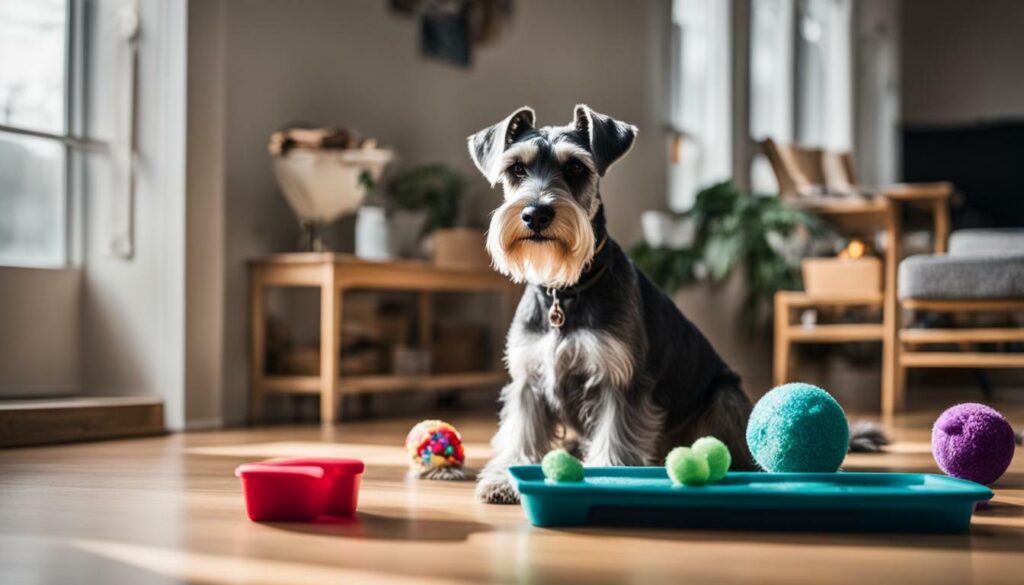
Leash Training
Leash training is essential for Miniature Schnauzers, as it ensures their safety and allows for better control during walks. Begin by familiarizing your dog with the leash and collar in a positive and relaxed environment. Gradually introduce short walks, using treats and praise to reward them for walking alongside you without pulling. Consistency is key, so be sure to reinforce good leash behavior consistently. With time and practice, your Miniature Schnauzer will become comfortable and well-behaved on the leash.
Table of Miniature Schnauzer Training Techniques:
| Training Technique | Description |
|---|---|
| Positive Reinforcement | Rewarding desired behavior with treats, praise, or play to reinforce understanding and encourage repetition. |
| Clicker Training | Using a clicker to mark desired behavior and pairing it with rewards to communicate and reinforce actions. |
| Leash Training | Teaching your Miniature Schnauzer to walk calmly on a leash by gradually introducing walks and rewarding good leash behavior. |
Incorporating these training techniques into your Miniature Schnauzer’s routine will help establish a strong bond with your furry companion while promoting their well-being and obedience. Remember, consistency and positive reinforcement are key to successful training. With patience and dedication, you can shape your Miniature Schnauzer into a well-behaved and happy member of your family.
Miniature Schnauzer Training Commands
Build a foundation of obedience and communication with your Miniature Schnauzer using these essential training commands. Teaching your dog these commands is crucial for their safety, well-being, and the harmonious coexistence with your family and community. By establishing clear expectations and consistent training, you can help your Miniature Schnauzer become a well-mannered and obedient companion.
Sit
The “Sit” command is a fundamental command that teaches your Miniature Schnauzer to sit down on command. Start with a treat in your hand, hold it above their head, and slowly move your hand backward. As your dog follows the treat with their eyes and nose, their natural response is to lower their rear end into a sitting position. The moment they sit, say “Sit” and reward them with the treat.
Stay
The “Stay” command is essential for keeping your Miniature Schnauzer in one place until you give them permission to move. Start by having your dog sit in front of you. Extend your hand in a stop gesture and say “Stay” firmly. Take a step back, and if your dog remains in the same position, reward them with praise and a treat. Gradually increase the time and distance before releasing them from the “Stay” command.
Come
The “Come” command is crucial for ensuring your Miniature Schnauzer returns to you when called. Begin by kneeling down and calling your dog’s name followed by the command “Come.” Encourage them with an excited tone of voice and open your arms wide for a welcoming gesture. When your Miniature Schnauzer approaches you, reward them with praise, affection, and a treat. Practice this command regularly in a safe and controlled environment.
Lie Down
The “Lie Down” command teaches your Miniature Schnauzer to rest on the ground in a relaxed position. Start by having your dog in a sitting position. Hold a treat in your hand and lower it to the ground in front of them while saying “Lie Down.” As your Miniature Schnauzer lowers their body, reward them with the treat and praise. Over time, gradually reduce the need for a treat and reinforce the command with verbal praise and affection.
| Command | Description |
|---|---|
| Sit | Teaches your dog to sit down on command. |
| Stay | Keeps your dog in one place until given permission to move. |
| Come | Ensures your dog returns to you when called. |
| Lie Down | Teaches your dog to rest on the ground in a relaxed position. |
By incorporating these essential Miniature Schnauzer training commands into your training sessions, you can establish a strong foundation of obedience and communication with your furry friend. Remember to be patient, consistent, and positive throughout the training process. With time and practice, your Miniature Schnauzer will master these commands and become a well-behaved and obedient companion.
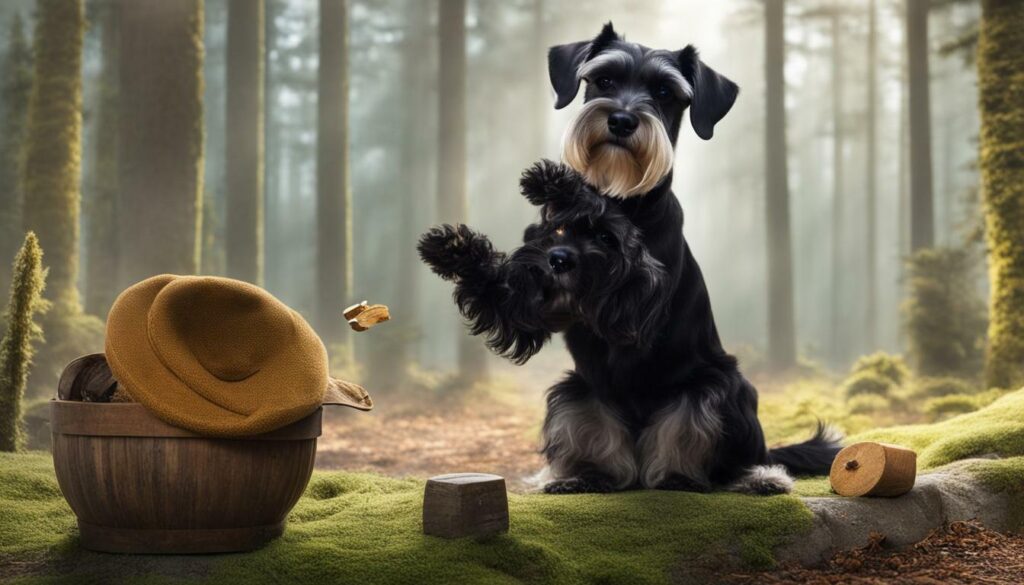
Establishing a consistent training schedule is key to successful training, and in this section, we will guide you in creating an effective plan. Training your Miniature Schnauzer at regular intervals helps establish routine and reinforce desired behaviors.
When creating a training schedule, consider your dog’s age, energy level, and attention span. Puppies may require shorter, more frequent training sessions, while adult dogs can handle longer sessions.
Sample Training Schedule:
| Time of Day | Activity |
|---|---|
| Morning |
|
| Afternoon |
|
| Evening |
|
Remember to keep training sessions positive and reward-based. Use treats, praise, and playtime as rewards to motivate your Miniature Schnauzer. Consistency is key, so stick to the schedule and be patient with your furry companion.
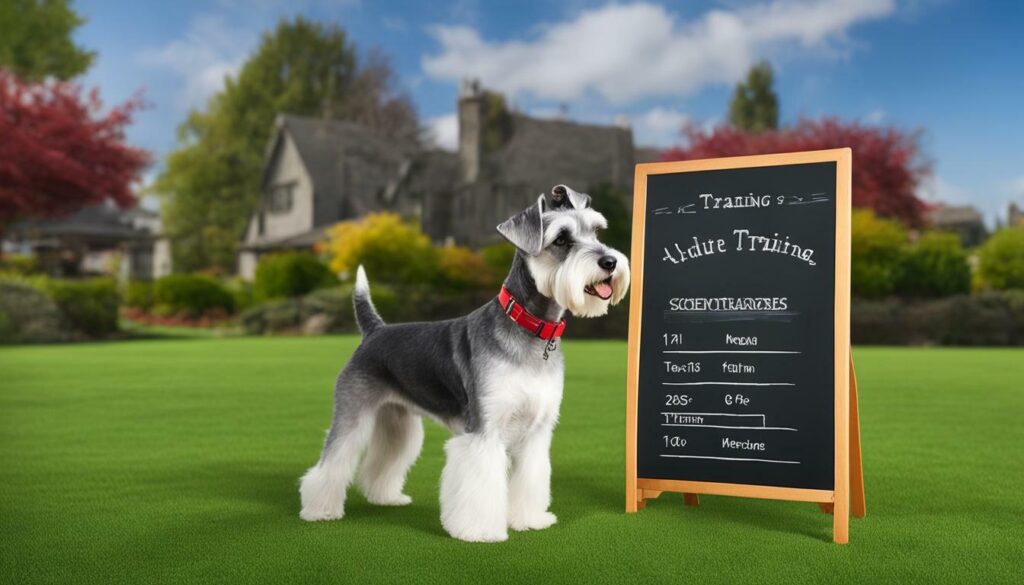
By following a structured training schedule, you can effectively teach your Miniature Schnauzer important commands, address behavioral issues, and create a strong bond with your furry friend. Training is an ongoing process, so be sure to practice regularly and adjust the schedule as needed. With dedication and patience, you will have a well-behaved and happy Miniature Schnauzer.
Miniature Schnauzer Crate Training
Crate training can be a useful tool in housebreaking and providing a safe space for your Miniature Schnauzer, and in this section, we will explore the ins and outs of crate training.
A crate serves as a den-like space where your Miniature Schnauzer can feel secure and comfortable. It can aid in toilet training by teaching your pup to hold their bladder and bowels until they are taken outside. Additionally, crates prevent destructive behavior and keep your dog safe when unsupervised.
When introducing your Miniature Schnauzer to the crate, make it a positive experience by providing treats, toys, and a cozy blanket. Place the crate in an area where your dog can still be part of the family activities.
| Benefits of Crate Training: |
|---|
| 1. Helps with housebreaking |
| 2. Prevents destructive behavior |
| 3. Offers a safe space for your dog |
| 4. Facilitates traveling with your Miniature Schnauzer |
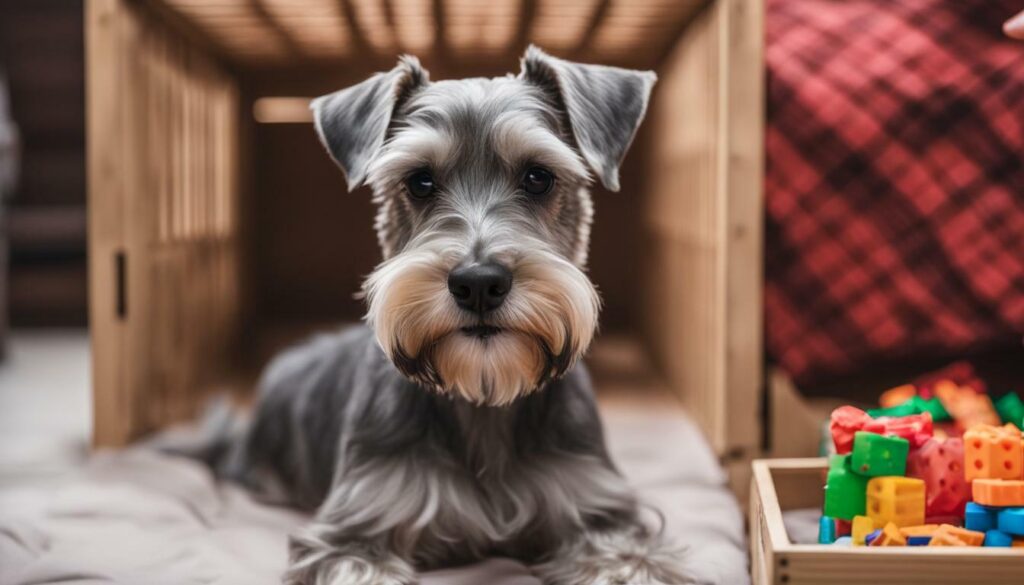
When crate training, start with short periods of time and gradually increase them as your dog becomes more comfortable. Never use the crate as a form of punishment or leave your Miniature Schnauzer in it for extended periods.
Tips for Successful Crate Training:
- Establish a routine for crate time, including mealtime and bathroom breaks.
- Make the crate cozy with a soft bed or blanket.
- Use positive reinforcement, such as treats and praise, to encourage your Miniature Schnauzer to enter and stay in the crate.
- Keep the crate clean and free of any unpleasant odors.
- Ensure the crate is the appropriate size for your dog, allowing them to stand, turn around, and lie down comfortably.
With patience and consistency, crate training can be an effective and humane way to train your Miniature Schnauzer. Soon, your furry friend will view the crate as their own special retreat, providing you with peace of mind and a well-behaved companion.
| Miniature Schnauzer Crate Training Schedule | |
|---|---|
| Age | Maximum Crate Time |
| 8-10 weeks | 1-2 hours |
| 11-14 weeks | 3-4 hours |
| 15-16 weeks | 4-5 hours |
| 17+ weeks | 5-6 hours |
Remember, every dog is unique, so adjust the crate training schedule based on your Miniature Schnauzer’s individual needs and behavior.
Miniature Schnauzer Training Troubleshooting
Training may not always go smoothly, but fear not! This section is here to provide troubleshooting tips for common training challenges. Whether you’re struggling with leash pulling, barking, or difficulty with a specific command, these tips will help you overcome obstacles and continue your Miniature Schnauzer’s training journey.
Leash Pulling
One common challenge during walks is leash pulling. To address this, try using a front-clip harness or head halter to redirect your Miniature Schnauzer’s attention and discourage pulling. Additionally, practice loose leash walking by rewarding your dog when they walk calmly by your side. Consistency and patience are key in overcoming leash pulling.
Excessive Barking
If your Miniature Schnauzer tends to bark excessively, it’s important to address this behavior. Start by identifying the triggers for their barking, such as the presence of strangers or other dogs. Once you understand the triggers, work on desensitization and counterconditioning techniques. Gradually expose your dog to these triggers in a controlled manner, rewarding calm behavior and redirecting their attention away from barking.
Command Difficulties
If your Miniature Schnauzer is struggling with a specific command, break it down into smaller steps and use positive reinforcement techniques. For example, if your dog has difficulty with the “stay” command, start by having them hold the position for a short duration, gradually increasing the time. Use treats and praise to reward their success. Remember to be patient and consistent in your training approach.
| Training Challenge | Troubleshooting Tip |
|---|---|
| Leash Pulling | Use a front-clip harness or head halter to redirect pulling behavior. Practice loose leash walking and reward calm behavior. |
| Excessive Barking | Identify triggers and gradually expose your Miniature Schnauzer to them in a controlled manner. Reward calm behavior and redirect attention away from barking. |
| Command Difficulties | Break commands into smaller steps, use positive reinforcement, and gradually increase difficulty. Be patient and consistent in training. |
Training your Miniature Schnauzer can be challenging at times, but with the right troubleshooting techniques, you can overcome these hurdles and continue building a strong bond with your furry friend. Stay positive, be patient, and remember that each dog learns at their own pace. By addressing common training challenges, you’ll be well on your way to having a well-behaved and obedient Miniature Schnauzer.
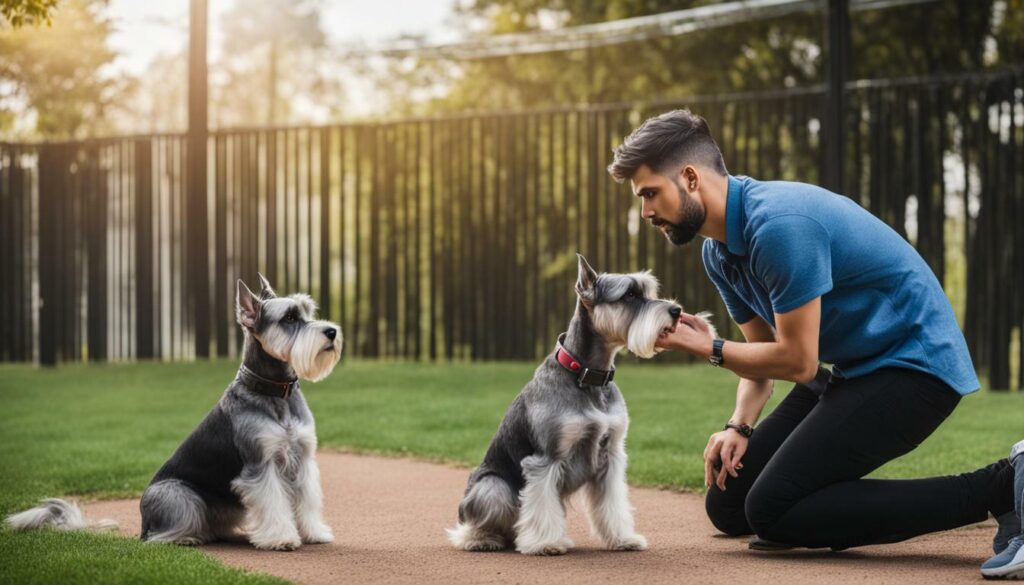
Enhance your Miniature Schnauzer training experience with these recommended resources tailored specifically for this breed. Whether you’re a novice owner or have years of experience with dog training, these resources will provide invaluable guidance and support.
1. “The Miniature Schnauzer Handbook”
Written by renowned dog trainer and Miniature Schnauzer expert, Dr. Emily Turner, this comprehensive handbook covers all aspects of training and caring for your Miniature Schnauzer. From basic obedience to advanced tricks, Dr. Turner’s expertise shines through in this easy-to-follow guide. The book also includes valuable tips on grooming, health, and nutrition, making it a must-have resource for any Miniature Schnauzer owner.
2. “Training Your Miniature Schnauzer: From Puppyhood to Good Citizen”
Authored by experienced dog trainer and behaviorist, Jane Collins, this training manual is specifically tailored to the unique needs and characteristics of Miniature Schnauzers. The book covers essential obedience training commands, behavior modification techniques, and strategies to address common behavioral issues. With step-by-step instructions and positive reinforcement methods, this guide will help you establish a strong bond with your Miniature Schnauzer while achieving desired training outcomes.
3. Online Training Courses
If you prefer interactive and hands-on learning, online training courses can be a great option. Websites like “Schnauzer Training Academy” and “Dog Training Excellence” offer comprehensive training programs specifically designed for Miniature Schnauzers. These courses provide video tutorials, live Q&A sessions, and personalized guidance from certified trainers, allowing you to learn at your own pace and address specific training challenges.
Remember, each Miniature Schnauzer is unique, so it’s important to find resources that cater to their specific needs. With these recommended training resources, you’ll have the knowledge and tools to ensure a positive and successful training experience for you and your Miniature Schnauzer.
| Resource | Description |
|---|---|
| “The Miniature Schnauzer Handbook” | A comprehensive guide by Dr. Emily Turner covering all aspects of Miniature Schnauzer training and care. |
| “Training Your Miniature Schnauzer: From Puppyhood to Good Citizen” | A training manual by Jane Collins tailored specifically to Miniature Schnauzers, addressing obedience training and behavior modification. |
| Online Training Courses | Websites like “Schnauzer Training Academy” and “Dog Training Excellence” offer interactive online courses for Miniature Schnauzer training. |
Explore these resources and embark on a rewarding training journey with your Miniature Schnauzer. Remember, consistent training and positive reinforcement are key to shaping a well-behaved and happy companion.
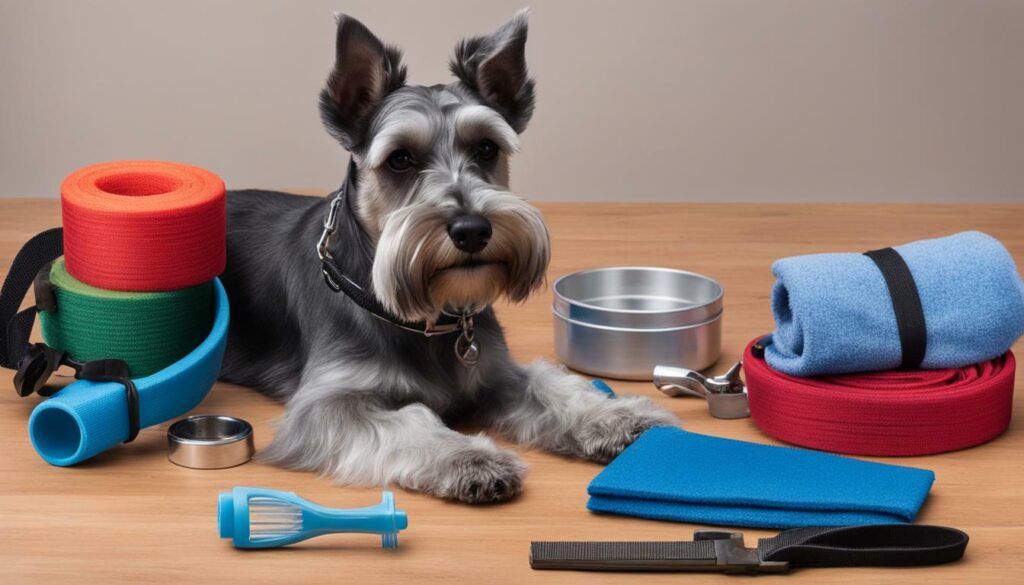
Congratulations! You now have all the tools and knowledge to successfully train your Miniature Schnauzer and enjoy the benefits of a well-behaved and obedient companion. Throughout this comprehensive training guide, we have covered a range of topics, from general training tips to specific obedience commands and behavioral issues.
By implementing the techniques and strategies outlined in this guide, you can establish a strong bond with your Miniature Schnauzer and create a harmonious living environment. Remember, training your Miniature Schnauzer requires patience, consistency, and positive reinforcement. With dedication and perseverance, you can shape their behavior and ensure they become a well-rounded and well-behaved member of your family.
From puppy training to obedience commands, behavior modification, and crate training, we have provided detailed insights and step-by-step instructions to guide you through each stage of the training process. Additionally, we have highlighted the importance of establishing a training schedule, incorporating playtime, and troubleshooting common challenges that may arise along the way.
You now possess the knowledge to navigate the intricacies of Miniature Schnauzer training confidently. However, if you find yourself seeking additional guidance, resources such as books, online courses, and professional trainers can further assist you in your training journey. Remember, training is a continuous process, and ongoing education and support can make all the difference in refining your Miniature Schnauzer’s skills and behavior.
FAQ
Q: What are some general tips for training a Miniature Schnauzer?
A: Training a Miniature Schnauzer requires patience, consistency, and positive reinforcement. It’s important to use rewards, such as treats or praise, to motivate and reinforce desired behaviors.
Q: What is obedience training for Miniature Schnauzers?
A: Obedience training focuses on teaching Miniature Schnauzers essential commands, such as sit, stay, come, and leash manners. This helps them become well-behaved and responsive to commands.
Q: How should I train my Miniature Schnauzer puppy?
A: Training a Miniature Schnauzer puppy involves crate training, potty training, and socialization. It’s important to establish a routine, provide positive reinforcement, and expose them to various environments and experiences.
Q: How can I address behavioral issues in my Miniature Schnauzer?
A: To address behavioral issues, such as barking, biting, or separation anxiety, it’s important to understand the underlying causes and use positive reinforcement techniques to redirect their behavior.
Q: What are some effective training techniques for Miniature Schnauzers?
A: Positive reinforcement, clicker training, and leash training are all effective techniques for training Miniature Schnauzers. These methods focus on rewarding desired behaviors and setting clear expectations.
Q: What are some essential training commands for Miniature Schnauzers?
A: Essential training commands for Miniature Schnauzers include sit, stay, come, leave it, and heel. These commands provide the foundation for good behavior and ensure their safety.
Q: How should I create a training schedule for my Miniature Schnauzer?
A: Creating a training schedule involves setting aside regular training sessions, incorporating playtime, and being consistent. Short, frequent sessions are more effective than long, sporadic ones.
Q: How do I crate train my Miniature Schnauzer?
A: Crate training involves gradually introducing your Miniature Schnauzer to their crate, making it a positive and comfortable space, and using it for potty training, rest, and containment when necessary.
Q: What should I do if I encounter training challenges?
A: When facing training challenges, it’s important to stay patient, reassess your approach, and seek guidance from professional trainers or resources. Troubleshooting tips can help you overcome obstacles.
Q: Are there any recommended training resources for Miniature Schnauzers?
A: Yes, additional resources such as books, online courses, and professional trainers can provide valuable guidance and support in training your Miniature Schnauzer.
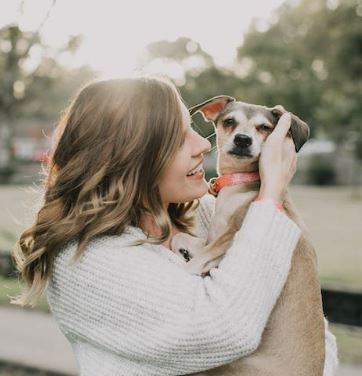
Marissa Delotta, 36, from Dayton, Ohio, is the creative force behind Roverboard.com, a beloved online destination for dog lovers. As a dedicated mom and canine enthusiast, Marissa combines her family experiences with her love for dogs to offer a platform where dog owners can exchange tips, heartwarming stories, and advice. Her website has become a vibrant community for sharing the joys of dog parenting. In her free time, Marissa enjoys exploring dog parks with her family and volunteering at local animal shelters.

